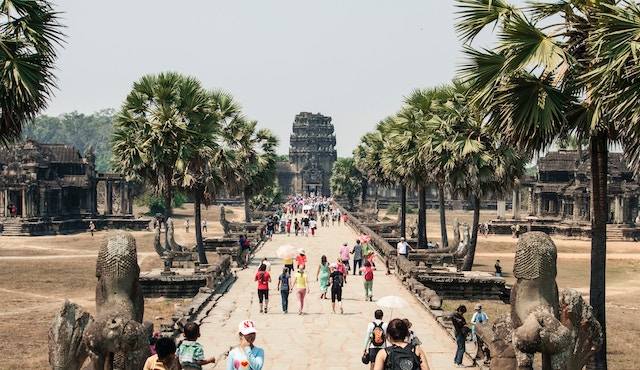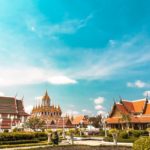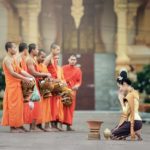Running the Angkor Wat Marathon in 52,000 Safe Steps

Scorching sun was the first thing to welcome me off the plane when I stepped off it in Siem Reap, Cambodia. It was just 8 a.m. when we landed. The next day at this time, I would be three-and-a-half hours into a non-stop run.
I arrived in Cambodia to run 42 kilometres among the sites of Angkor Wat, the largest religious monument in the world. It was my first time in this country and my first time to run in such a big race. Sure, I had been running for a few years now and had even added “running a marathon” to my vision board.
But I could hardly imagine myself really doing it. Cambodia was the deal-breaker. I remembered countless pictures of crumblings walls and trees embracing the stones that my friends had shown me from their trips to Siem Reap. Running in that surrounding just sounded way too exciting to pass up!
It was my first time in this country and my first time to run in such a big race.
The next morning at 4 a.m., a tuk-tuk drove me though the sleeping town and dropped me somewhere in the middle of a chaotic crowd made of runners, organisers and the police all getting ready for the race (nearly in the dark). Some experienced runners brought pocket flashlights. In the poor light brightened by occasional street lamps, we could not see more than couple metres ahead of us at the start line.
Yet, I knew that Angkor Wat was already around us. Can it be possible to feel the presence of the ancient Khmer temple before you could actually see it? I remember gazing in the dark, trying to see anything beyond runners stretching their calves.
As the race begins, the first part of the road leads away from the temple complex back to the town. Enjoying fresh morning air and bursting with excitement, I easily reach the centre of Siem Ream around the sunrise hour. It is not a touristy centre but a lively, bustling road near a local morning market where everyone is busy trying to buy and sell for the day before it gets too hot.
But for the runners, there is no time to see what’s in those stalls or what that dog is stealing from an energetic sales women. Tuk-tuks and cyclists will gladly share their road with runners, but it’s up to you to watch out and make sure you don’t get run over by them.
Can it be possible to feel the presence of the ancient Khmer temple before you could actually see it?
Keeping up with the marathon crowd, I leave the town behind. We are now running through the rice fields, and the landscape is quickly getting monotonous. Occasional lotuses in the muddy stocks, street dogs and few houses alternate while I’m taking step, after step, after step. This marathon is held to support the ban on manufacture and the use of antipersonnel mines in Cambodia.
Years after war and civil conflicts, the country is still infested with landmines which cause hundreds of injuries per year. Yet more and more people every year are flying in to run on 42 kilometres of Cambodian roads. If you’ve ever took part in any organised race before, you’ll find that Angkor Wat Marathon is missing quite a few essentials such as street lights, roads blocks or even regular bathrooms along the way.
Yet, if you consider that every step you take during these 42 kilometres is a safe step in a country still filled with landmines, you get a completely different perspective on what these 52,000 safe steps mean for Cambodia.
Finally, 30 kilometres into the race, I reach the Angkor Wat complex. This is the moment I was waiting for. Local kids have all put on their school uniforms to line up by the side of the road and give me and other runners the most energetic high-fives that we can possibly take at this point (seriously). I’ve been running for nearly 4 hours and have to slow down for a quick sip of water at every recharge station.
If you consider that every step you take during these 42 kilometres is a safe step in a country still filled with landmines, you get a completely different perspective
Unlike my mind, my body has no idea that the marathon will be over soon. Somewhere around kilometre 35, it’s way far too into the race to stop yet too far from the finish line to feel relief. At this point, the experience becomes one of extreme concentration as I cannot allow my body to protest and take over my mind.
All that matters is that I keep on moving the right leg after the left, left leg after the right. I’m literally commanding every single muscle move and waiting for the body to execute them, the quiet battle staged against world-famous sights.
During the few kilometres, the experience turns truly unreal. At the peak of mental and physical focus, my mind can only register all that is happening around with no space for reactions. Elephants, wild monkeys and pigs, tuk-tuks, tourists and temples are all blending into one crazy carousel until I notice THE FINISH LINE sign ahead. My legs begin to automatically move faster, no need for the commands anymore.
Check out Pink Pangea’s Writing, Yoga, and Meditation Retreats.
When running alone through the roads of Angkor Wat temple, you have plenty of time to connect to the place on a different level than tourists do. After four-and-a-half hours in the temple complex, I barely have any pictures. Still, I can vividly recall the wide range of emotions I felt there. I spent hours imagining people who put one brick on top of another, nearly a thousand years ago.
I had time to hate every single one of those bricks, simply out of exhaustion. I felt a relief of noticing a finish line ahead. I had time to look around and appreciate the place. I had time to look inside myself and find my emotions awakened and to be present like never before. I had the chance to live and to capture the experience better than any camera could.
Running the Angkor Wat Marathon in 52,000 Safe Steps photo by Unsplash.








